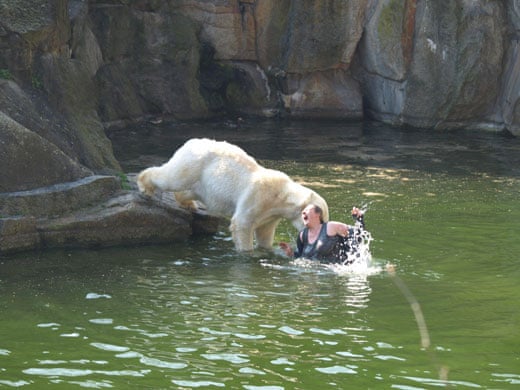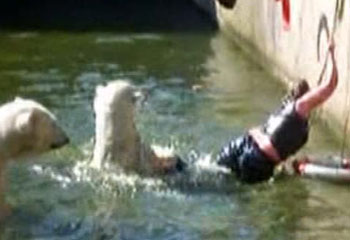A shocking incident unfolded at the Berlin Zoo when a woman was attacked by a polar bear after jumping into its enclosure. Witnesses were left stunned as the unexpected event quickly escalated into a dangerous encounter that could have turned deadly. The zoo, known for its extensive collection of animals and carefully maintained habitats, had never experienced such a dramatic breach of safety in recent memory. The incident drew immediate attention from both the public and the media, raising questions about safety protocols, visitor behavior, and the unpredictable nature of wild animals even in captivity.
The attack occurred during the zoo’s regular visiting hours on a day that began like any other. Families, tourists, and animal enthusiasts were enjoying the exhibits when chaos erupted near the polar bear enclosure. According to eyewitnesses, the woman deliberately climbed over the barriers that separate visitors from the bears. Despite visible warning signs, she made her way into the restricted area and jumped into the water-filled section of the enclosure where one of the zoo’s polar bears was swimming. The animal, startled and likely perceiving her presence as a threat or intrusion, reacted aggressively.
Zoo staff were alerted immediately and initiated an emergency response. Polar bears are apex predators, capable of delivering fatal injuries with a single bite or swipe of their powerful paws. In this case, the bear bit the woman several times before zoo personnel managed to distract it and pull her to safety. The rescue operation involved the use of firecrackers and other noise devices to divert the bear’s attention. Meanwhile, security and medical teams worked together to stabilize the woman and transport her to a nearby hospital for urgent treatment. Her injuries, while severe, were reported to be non-life-threatening thanks to the swift intervention.
Investigations revealed that the woman had no apparent connection to the zoo or its staff. Authorities have yet to confirm her motives, though some speculate she may have been experiencing a mental health crisis. Others believe it might have been an act of recklessness or a misguided attempt to interact with the bear. Whatever the reason, her actions put both herself and the animal in extreme danger. The polar bear, though unharmed physically, was subjected to an incredibly stressful situation that could have lasting effects on its behavior.
Polar bears are among the largest land carnivores on Earth, with adult males weighing between 350 and 700 kilograms and possessing immense physical strength. Their natural habitat is the Arctic, where they rely on sea ice to hunt seals and survive the harsh environment. While zoo enclosures replicate certain aspects of this habitat, the confined space and close proximity to humans can create unpredictable dynamics. Even when raised in captivity, polar bears retain their natural instincts, and their behavior can shift suddenly in response to perceived threats or changes in their environment.

This incident has reignited a broader debate about zoo safety and the responsibilities of visitors. Berlin Zoo, like many other modern zoological institutions, has invested heavily in secure enclosures designed to prevent direct contact between humans and dangerous animals. These designs typically include moats, glass walls, fences, and other physical barriers, as well as extensive signage warning visitors of the risks. However, as this case demonstrates, no system can be entirely foolproof if individuals choose to ignore safety measures.
Zoo officials have emphasized that such breaches not only endanger the intruder but also jeopardize the welfare of the animals. In extreme cases, zoos may be forced to euthanize animals that injure or kill humans, even when acting in self-defense. Fortunately, in this instance, the polar bear was spared such a fate. Still, the stress of the incident could affect its well-being, and behavioral experts will likely monitor it closely in the coming weeks.
Public reaction to the attack has been mixed. Some have expressed sympathy for the woman, citing possible mental health struggles. Others have criticized her actions as reckless and irresponsible, pointing out the risks to both herself and the bear. Social media discussions have been particularly heated, with many calling for stricter security measures at zoos and harsher penalties for individuals who deliberately endanger themselves or the animals.
Authorities in Berlin are now reviewing the circumstances of the incident to determine whether criminal charges will be filed. Trespassing into a dangerous animal enclosure can carry significant legal consequences, including fines and possible jail time. Mental health assessments may also play a role in the legal process, depending on the findings of investigators.
In the aftermath, Berlin Zoo has reiterated its commitment to visitor safety and animal welfare. Officials have stated that they will review their existing security measures to identify potential improvements. Additional staff training, increased surveillance, and further physical modifications to enclosures are among the steps being considered. They have also reminded the public that the barriers and safety rules are in place not only to protect people from harm but also to ensure the animals are not subjected to unnecessary stress or forced into situations where they might have to defend themselves.
This dangerous encounter serves as a stark reminder of the unpredictable nature of wildlife, even in controlled environments. Polar bears, like all wild animals, are driven by instinct and should be treated with respect and caution. Zoos play a vital role in conservation and education, but they also depend on visitors to act responsibly. By following safety guidelines, staying behind barriers, and respecting the animals’ space, visitors can help ensure that such incidents remain rare and that both humans and animals can coexist safely in these shared spaces.




